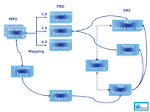I have received several questions regarding the evolution of ALM and ALM systems.
Following post is a brief regarding the Application lifecycle management generations and evolution
Before ALM - There were some tools, or even no tools at all, and each tool did its role. There was no synchronization between the tools.
ALM 1.0 Tools (before even the term ALM was too common) was a set of separated tools that were synced manually in the best case.
ALM 2.0 is the unified platform for all development aspects, one repository, strong analytics and sharing of common services such as security, workflows, templates, etc.
ALM 2.5 (A new term I thought of...) is the next generation of application lifecycle management tools, talks about using the data collected during the development, define behavioural patterns and proactively generate alerts and metrics that will help the organization taking the right decisions, while taking into account every aspect of the development.
Each change submitted will list all the affected areas in the system, will show relevancy rank of affected items and show quality rank for each affected item.
More on that on my next posts....
Friday, May 29, 2009
Sunday, May 24, 2009
The importance of requirements management
The following post discusses the importance of requirements management:
- The requirements management is the “technical language” that collaborates customers, marketing, development and QA
- Gathering, documenting, verifying, and managing requirements throughout the lifecycle ensures satisfying customer needs
- Requiremnts management assures finding defects earlier in the development process
- Keep product definition up-to-date and
- Communicate changes to the R&D
- Ensures that iterative refinements and unanticipated changes are adequately dealt with during the developemnt lifecycle
- Reduce communication overhead with customer and reduce number of patches delivered to customers for each release
Friday, May 22, 2009
How important is to Jump Start with ALM professional service program?
It’s not easy for software companies to improve operating efficiency while responding to market changes. Improving productivity across business processes requires visibility, speed, and automation. The ALM professional services program can tailor the ALM software to your needs and roll it out quickly and, it can be adapted to changing requirements. Find out how it can grow with your company.
Whether you device manufacture industrial components or software vendor, your success depends on how quickly and effectively you adapt to change. Coping with evolving customer demands, government regulations, and your own market requires constant innovation to bring new products and services to market while controlling costs especially information technology costs.
It is a challenge to be competitive as well as efficient and profitable.
Even with a local customer base, you are likely operating in an integrated global environment where stakeholders are placed around the globe. Limited visibility into business drivers can hamper your efficiency, ALM introduce a well define concept of information gathering at the same time. Rising costs and shrinking cycle times for software development require increased internal efficiencies from flexible software development methods to streamlined order fulfillment. To improve productivity across business processes, you need visibility, speed, and automation. The ALM professional service program is designed to help you tailor an ALM unified platform solution to your needs and get it up and running quickly. Complete with preconfigured system, the program should be easily adaptable to changing requirements, growing with your business. The ALM unified platform solution supports the processes you perform to meet daily business needs from market requirements and product requirements roadmap planning to development and testing and deployment at customer site. When you have selected ALM solution to your organization, at the same time make sure you have preset resources to the implementation program which will enable your employees to make most out of the ALM solution .
Whether you device manufacture industrial components or software vendor, your success depends on how quickly and effectively you adapt to change. Coping with evolving customer demands, government regulations, and your own market requires constant innovation to bring new products and services to market while controlling costs especially information technology costs.
It is a challenge to be competitive as well as efficient and profitable.
Even with a local customer base, you are likely operating in an integrated global environment where stakeholders are placed around the globe. Limited visibility into business drivers can hamper your efficiency, ALM introduce a well define concept of information gathering at the same time. Rising costs and shrinking cycle times for software development require increased internal efficiencies from flexible software development methods to streamlined order fulfillment. To improve productivity across business processes, you need visibility, speed, and automation. The ALM professional service program is designed to help you tailor an ALM unified platform solution to your needs and get it up and running quickly. Complete with preconfigured system, the program should be easily adaptable to changing requirements, growing with your business. The ALM unified platform solution supports the processes you perform to meet daily business needs from market requirements and product requirements roadmap planning to development and testing and deployment at customer site. When you have selected ALM solution to your organization, at the same time make sure you have preset resources to the implementation program which will enable your employees to make most out of the ALM solution .
Thursday, May 14, 2009
140 words – ALM Analytics and reports – Optimal Requirements vs. Test creation trend
This report usually generated from ALM system that contains requirements management and test management module.

1. Requirements definition - at the beginning of the application lifecycle, the requirements creation trend is higher, later on used by development team and QA team.
QA starts writing his test plan, but in lower rate.
2. End of Requirements definition - QA continues writing test cases.
3. Equation point 1- where number of tests equal to number of requirements.
4. Start QA cycles - start running tests in QA cycles. At this phase, we usually have more test cases than requirements to assure requirements coverage.
5. Next release starts - product manager submits requirements for next release.
6. Equation point 2 - Number of requirements is equal to number of test cases. The same application lifecycle occurs again.

1. Requirements definition - at the beginning of the application lifecycle, the requirements creation trend is higher, later on used by development team and QA team.
QA starts writing his test plan, but in lower rate.
2. End of Requirements definition - QA continues writing test cases.
3. Equation point 1- where number of tests equal to number of requirements.
4. Start QA cycles - start running tests in QA cycles. At this phase, we usually have more test cases than requirements to assure requirements coverage.
5. Next release starts - product manager submits requirements for next release.
6. Equation point 2 - Number of requirements is equal to number of test cases. The same application lifecycle occurs again.
Subscribe to:
Posts (Atom)




